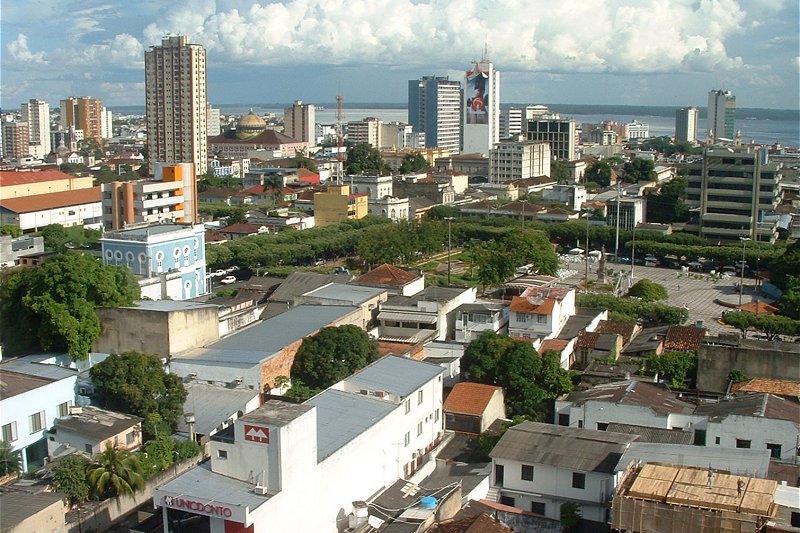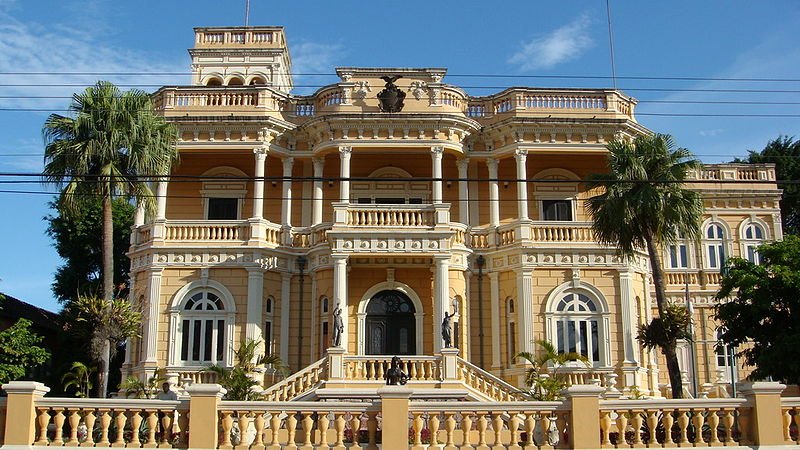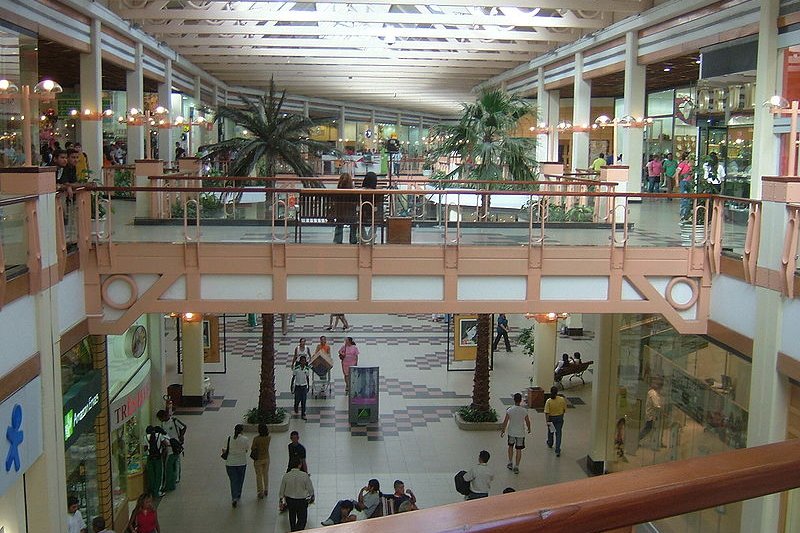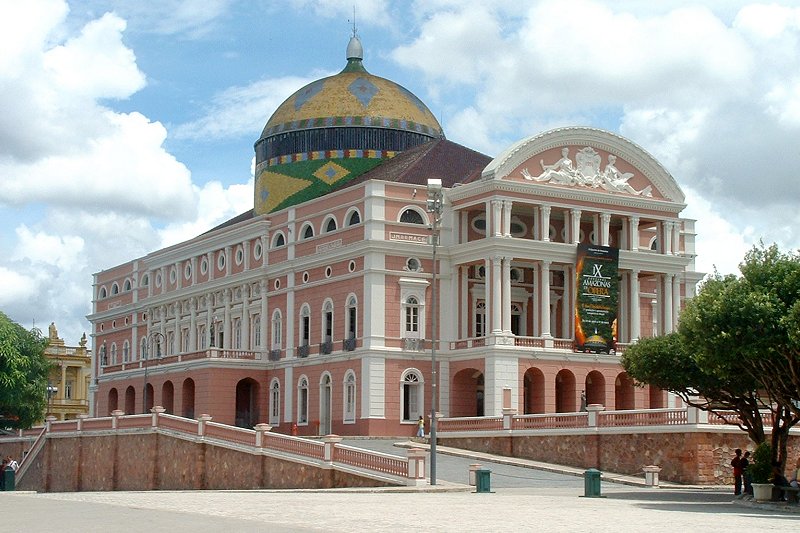 Manaus, Brazil
Manaus, BrazilSource: https://commons.wikimedia.org/wiki/File:Manaus_downtown.JPG
Author: Pontanegra

Manaus is the state capital as well as most populous city in Amazonas. It is a bustling city surrounded by the dense Amazon rainforest. Located 1,935 km (1,203 mi) from Brasília, and covering 11,401 sq km (4,402 sq mi), Manaus supports a population of 1.74 million people today (2011 estimate), making it the 8th largest city in Brazil.
Manaus is located at the confluence of the Negro and Solimões rivers, not far from the Amazon river. Half the people in the Amazon basin live in Manaus. The city has over the years continued to grow its presence as being one of the 12 most influential in Brazil, contributing close to 1.5% to the country's economy.
Manaus experiences a tropical monsoon climate. There is a distinct wet season (November to May) and a dry season (June to October) in the city, although temperature tends to be fairly uniform throughout the year, with slight variation. September is the warmest month, when the average high temperature regularly registers at 32.9°C (91.2°F). On the other hand, July has the lowest average low temperature, at 22.7°C (72.9°F).
 Palácio Rio Negro, Manaus
Palácio Rio Negro, ManausSource: https://commons.wikimedia.org/wiki/File:Pal%C3%A1cio_Rio_Negro,_Manaus_1.jpg
Author: Madison

European settlement in Manaus was started in 1669, when Fort São José da Barra do Rio Negro was built there. The fort was intended to keep the Dutch at bay. A village was established around the fort, and it over time grew to become Manaus. In 1695, the Chapel of Our Lady of the Conception was built. Our Lady of the Conception became the patron saint of the city.
Manaus experienced a rubber boom in the late 19th century, when it had a monopoly on the production of rubber, creating a number of fabulously wealthy rubber baron. However the monopoly was not to last. Seeds of the rubber tree was smuggled out of the Amazon region, and soon other countries in Asia and Africa were also exporting rubber, eroding the prices and Manaus, which was abruptly rich, was poor once again.
 Amazonas Shopping Mall, Manaus
Amazonas Shopping Mall, ManausSource: https://commons.wikimedia.org/wiki/File:Am_shopping_manaus.jpg
Author: pontanegra

The fortunes of Manaus was reversed in the mid 20th century when it was turned into a duty free zone. This has helped the city bounce back.
Visiting Manaus
Manaus Airport (Brigadeiro Eduardo Gomes-Manaus International Airport, MAO) gets flights from major cities in Brazil as well as Miami and Panama City. Teatro Amazonas, Manaus
Teatro Amazonas, ManausSource: https://commons.wikimedia.org/wiki/File:Teatro_amazonas.jpg
Author: Pontanegra

Sights & Attractions in Manaus
- Alfândega
The Manaus Customs House, built in 1906 when the city was experiencing its rubber room. At that time, the city was so rich that the whole built was prefabricated in England and shipped over. - Mercado Municipal Adolfo Lisboa
This is the main market of Manaus. Built in 1902, it is a good place to see all the jungle produce that passes through the city. In addition to the exotic fruits and vegetables, you can also find some tribal handicrafts at low prices. - Museu do Homen do Norte (Museum of the Northern Man)
This museum of anthropology and ethnology looks at the way of life in northern Brazil. - Museu do Índio
Museum founded by Salesian nuns that looks at the native Indians in the Rio Negro area. On display are the Indian handicrafts, tools and weapons as well as musical instruments and sacred objects. - Palácio Rio Negro
One of the opulent mansions of the 19th century rubber baron, preserved to show the eccentricity of German rubber baron Waldermar Scholz. - Teatro Amazonas
Manaus Opera House, another manifestation of rubber wealth, was built at the end of the 19th century, when the city was awashed with money from rubber. - Zoológico do CIGS
This is a small zoo specializing in the wildlife of the Amazon.
Sights & Attractions around Manaus
- Encontro das Aguas (Meeting of the Waters)
This is a boat excursion to see the confluence of the Rio Solimões with the Rio Negro, where the clay-colored water of the Rio Solimões blends with the dark water of the Rio Negro. - Lago Mamori
A beautiful elongated lake surrounded by the rainforest, a good place to view the wildlife as well as the local people who make a living in riverside communities on the lake. - Lago Manaquiri
This is a backwater lake some 5 hours by boat from Manaus.It is a good spot for viewing the birdlife of the Amazon. - Novo Airão
Small town on the western part of the Rio Negro. The attraction here are pink dolphins which often visit the platform of the restaurant at the port. - Presidente Figueiredo
A small town with many waterfalls and caves, located about 100 km (62 mi) north of Manaus. The waterfalls include Cachoeira Iracema, Pedra da Lua Branca and Natal, while the caves are Caverna Araras and Caverna Maruaga. - Rio Negro and Ilha de Anavilhanas
The Rio Negro area has distinctive plants due to its acidic water and soil. Ilha de Anavilhanas is the largest group of freshwater islands in the world, and an important biological reserve.
 Latest updates on Penang Travel Tips
Latest updates on Penang Travel Tips
Songs about Penang
About this website

Hello and thanks for reading this page. My name is Timothy and my hobby is in describing places so that I can share the information with the general public. My website has become the go to site for a lot of people including students, teachers, journalists, etc. whenever they seek information on places, particularly those in Malaysia and Singapore. I have been doing this since 5 January 2003, for over twenty years already. You can read about me at Discover Timothy. By now I have compiled information on thousands of places, mostly in Peninsular Malaysia and Singapore, and I continue to add more almost every day. My goal is to describe every street in every town in Malaysia and Singapore.
Copyright © 2003-2024 Timothy Tye. All Rights Reserved.


 Go Back
Go Back